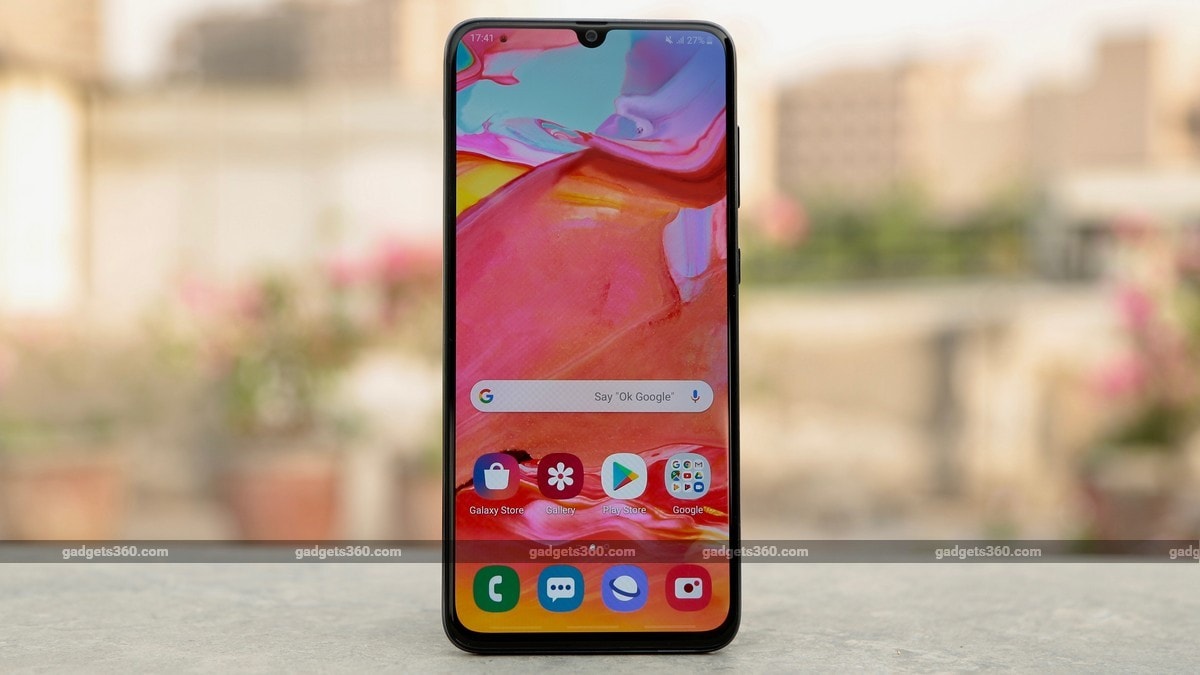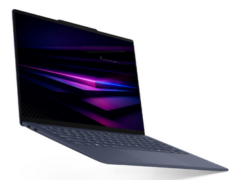- Home
- Mobiles
- Mobiles Reviews
- Samsung Galaxy A70 Review
Samsung Galaxy A70 Review
Samsung Galaxy A70 offers appealing aesthetics and a promise of great multimedia experience, but is that enough to rise above the competition?

The Samsung Galaxy A70 comes to India carrying a price tag of Rs. 28,990
Samsung has charted the course for its comeback in the mid-range segment with the rejuvenated Galaxy A-series, introducing a new lineup that has seen flagship features trickle down the price ladder. The Galaxy A70 is Samsung's latest attempt at offering a premium experience at less than half the cost of a flagship phone, with features including an in-display fingerprint sensor, triple rear cameras, and a large Super AMOLED display, to name a few. There's also support for Samsung Pay, making the Galaxy A70 one of the few Galaxy A-series phones to offer this feature.
The Galaxy A70's position in Samsung's smartphone lineup is a bit confusing as it shares key internal specifications with the recently launched Galaxy A60. Surprisingly, the Samsung Galaxy A70 misses out on the hole-punch front camera, which is considered fashionable these days. Even more perplexing is the fact that the Galaxy A60 is priced at roughly two-thirds of the Galaxy A70's asking price, in countries where the former is currently available.
Comparisons aside, the Samsung Galaxy A70 falls in a price bracket that is populated by previous-gen budget flagships as well as some appealing smartphones from the likes of Nokia, Vivo, and Oppo, which pose stiff competition. Can the Samsung Galaxy A70 hold its own in a fiercely competitive segment, and does it offer a smartphone experience worth its price? Read on to find the answer in our Galaxy A70 review.
Samsung Galaxy A70 design
The Samsung Galaxy A70 looks like a super-sized version of the Galaxy A50, and that is not a bad thing. The Galaxy A70 inherits the A50's curved edges and the iridescent gradient effect on its rear panel. While other brands are experimenting with different colour schemes and patterns, Samsung has gone with an understated dark shade of grey, and topped it off with an iridescent layer that changes colours beautifully when light reflects off it at different angles.
The Samsung Galaxy A70 comes in a total of three colour options viz. Black, White, and Blue, all three of which exude the iridescent gradient effect, but to a different extent. The smartphone is a blend of metal, plastic, and glass. The glossy rear panel looks like it is made of glass, but is actually plastic that mimics the depth and reflective properties of glass.
The rear panel is subtly tapered around the edges and blends almost seamlessly with the metallic rim, which also has a curved profile to provide a better grip. This makes the device feel thinner than it actually is.
The three vertically stacked rear cameras on the Samsung Galaxy A70 are housed inside a module that creates a small bulge, while the LED flash sits below it. The power and volume buttons are positioned on the right and provide nice tactile feedback on being pressed.
Sadly, this phone gets smudged easily, attracting fingerprint marks and dirt particles. While the bundled protective case will help with the former, it creates a bit of hindrance while using swipe gestures for Android UI navigation.
There is single mic at the top, while the USB Type-C port, speaker, 3.5mm headphone jack, and a primary mic are located on the bottom. Along the left side of the Samsung Galaxy A70 is the SIM card housing, whose tray can simultaneously take two Nano-SIM cards and a microSD card of up to 512GB capacity. It is good to see three individual slots, as users won't have to choose between dual-SIM functionality and storage expansion.
The Samsung Galaxy A70 looks and feels great, but the sheer size of this device must be taken into consideration before you buy it. At 164.3x76.7x7.9mm, the Galaxy A70 is not a small device by any means. One-handed usage is out of the question since it's hard to reach all points on the screen with one thumb. We often found ourselves struggling to reach controls at the top of the screen without having to adjust our grip on the device. Thankfully, the weight distribution is uniform.
As far as box contents go, the Galaxy A70's retail package includes the smartphone itself, a transparent protective case, SIM eject pin, USB Type-C cable, 3A/9V Super Fast Charging adapter, a headset, and some paperwork.
Samsung Galaxy A70 specifications and software
The Galaxy A70 is equipped with a 6.7-inch full-HD+ (1080x2400 pixels) Super AMOLED Infinity-U display with 20:9 aspect ratio. This new Galaxy A-series entrant is powered by the Snapdragon 675 SoC which has two Kryo 460 performance cores clocked at 2GHz and six efficiency cores clocked lower at 1.7GHz.
The Snapdragon 675 ticks alongside 6GB of RAM and 128GB of internal storage, which can be expanded by up to 512GB using a microSD card. Samsung has also announced a variant of the Galaxy A70 with 8GB of RAM, but it appears that only the 6GB RAM version has made its way to India so far. There's a 4,500mAh battery with support for 25W fast charging, using the ‘Super Fast Charging' adapter that comes in the box.
In the imaging department, Samsung has equipped the Galaxy A70 with three rear cameras. There's a 32-megapixel primary camera with an f/1.7 aperture, assisted by an 8-megapixel ultra-wide camera with an f/2.2 aperture and 123-degrees field of view, and a 5-megapixel depth sensor with an f/2.2 aperture. At the front is another 32-megapixel camera with an f/2.0 aperture.
As far as photography goes, there are a lot of features to play with. The Samsung Galaxy A70 offers Live Focus, AR emojis, and Super-Slo-Mo video recording, to name a few of its modes. Unfortunately, there is no dedicated mode for low-light photography, or any form of stabilisation to cancel out shaking when recording videos.
The Galaxy A70 runs Samsung's One UI based on Android Pie, with our review unit running the March security patch. From the get-go, One UI has a more minimalist and modern feel to it compared to the older Samsung Experience UI, which for some reason, is still found on the Galaxy M-series of smartphones.
A few aspects we particularly like about One UI are that the aesthetics are significantly better, and there are usability improvements specifically designed for large screens, such as being able to pull controls at the top of the screen downwards to where they're within reach.
The icons are a bit large and there is a lot of spacing between them, but thankfully, you can adjust the grid layout to squeeze in more apps and also tweak font parameters like styling, contrast, and text size with relative ease. Moreover, OneUI lets you choose between a dedicated button and an upward swipe to pull up the app drawer.
![]() The Galaxy A70 packs triple rear cameras, but misses out on a dedicated Night Mode
The Galaxy A70 packs triple rear cameras, but misses out on a dedicated Night Mode
You can choose between navigation buttons and gestures, but unlike the swipeable navigation pill on stock Android, One UI simply substitutes the navigation buttons with three horizontal bars that can be swiped upwards. Although it works well and also allows users to switch the order of the buttons, we still prefer the navigation gestures on Google's Pixel phones.
Swiping right on the first home screen opens the Bixby Home page which is populated by customisable cards for the calendar, weather, and email, among others. This also acts as a content discovery page by pulling transient content from apps such as Twitter, Facebook, and UC News, and also shows information such as usage statistics. The design of the Bixby home screen is clean and we particularly liked the look when Night mode is enabled.
There are a host of useful features such as an always-on display mode, ‘Face Widgets' which show controls for music playback and reminders on the lock screen, Google's Digital Wellbeing to keep a track of phone usage statistics. There is also a feature called ‘Separate app sound' which plays sounds from one app on the phone's speaker, and those from another app through a connected device such as a Bluetooth speaker.
Unlike the Galaxy A50, which only offers Samsung Pay Mini, the Galaxy A70 supports Samsung Pay, which can take advantage of both NFC and MST (Magnetic Secure Transmission) technologies to let users make contactless offline payments. It is basically equivalent to carrying a debit or credit card. You can read more about the difference between Samsung Pay and Samsung Pay Mini in our article.
The Samsung Galaxy A70 comes with a host of preinstalled third-party apps such as Netflix, Dailyhunt, Amazon Shopping, Prime Video, Microsoft Office, OneDrive, and LinkedIn, in addition to Samsung's own apps. Now here is the bad part — the in-house apps are ad machines and send a tonne of spammy notifications as well. The MyGalaxy app in particular dishes out ads left and right, with some of them being rather annoying. Thankfully, one can stop these spammy notifications and ads by disabling the offers and transaction toggle on a per-app basis.
The MyGalaxy app is supposed to be a one-stop shop for content such as videos, music, news, and games. While the former three sections are useful to some extent, the games section is populated by titles that are simply not worth downloading in our opinion. You can read more about One UI in our Samsung Galaxy A50 review.
Samsung Galaxy A70 performance, cameras, and battery life
The large 6.7-inch Super AMOLED display is really good and is a key highlight of the Galaxy A70. Colours just pop out, on-screen content is vibrant and crisp without any fuzziness or oversaturation, and we get deep blacks and great contrast. Be it games or watching videos on Netflix, the quality of the screen ensured a very good viewing experience.
Even though the large screen makes the Samsung Galaxy A70 difficult to handle, it has its perks. First-person shooter (FPS) games were particularly enjoyable, as the large display not only makes content more immersive, but also allows on-screen controls to be well-spaced.
The viewing angles are great, and we also did not face issues when using the device under daylight. While Samsung has not provided a specific figure in nits about the peak brightness, we barely felt the need to push the brightness slider above the 80 percent mark.
The phone's adaptive brightness feature works well, and there is also a blue light filter mode to cut down on blue light exposure. One can choose between Vivid and Natural modes, adjust the colour temperature of the screen as well as its white balance. We preferred the Vivid mode, as the Natural mode made colours look a little muted and dim.
![]() The Galaxy A70 flaunts a glossy rear panel that exudes an iridescent gradient finish
The Galaxy A70 flaunts a glossy rear panel that exudes an iridescent gradient finish
Samsung has gone the Qualcomm route with the Galaxy A70, eschewing its own in-house Exynos processors in favour of the Snapdragon 675 SoC. The Snapdragon 675 has proved to be a reliable processor, and in our Redmi Note 7 Pro and Vivo V15 Pro reviews, we observed that it handles gaming as well as day-to-day tasks without a hiccup. With that said, given the the asking price of the Samsung Galaxy A70, one can argue that a Snapdragon 700-series processor would have been a better fit.
Starting with synthetic benchmark scores, the Galaxy A70 scored 2,390 and 6,490 in Geekbench's single-core and multi-core tests respectively. In AnTuTu, the phone put up a tally of 169,342. Coming to the more graphics-intensive tests, the Galaxy A70 achieved 974 and 22,819 points in 3DMark Slingshot Extreme and 3DMark Ice Storm Unlimited. The phone also managed 36fps in GFXBench T-Rex and 7.7fps in GFXBench Car Chase.
Coming to day-to-day usage, we did not encounter any stutter or lag while switching between apps, surfing social media sites, editing photos, or in any other scenario. The Galaxy A70 also handled games quite well. PUBG Mobile and Asphalt 9: Legends ran at high settings, providing smooth gameplay experiences without any stutters. Also, we did not come across any heating issues.
The Samsung Galaxy A70 also features Dolby Atmos support for providing a better multimedia experience with surround sound effect. We tested it by playing music videos and some high-octane movie action scenes, and found that it does make the experience more immersive. There is a Dolby Atmos toggle in the notifications shade. As for the onboard speaker, it can get loud and has a wide sound profile, but at peak volume, there is some distortion.
The bundled headset is only good for making calls. The earbuds are quite small and there are no additional rubber tips in other sizes to help get a better in-ear fit. A lot of background noise seeps in while listening to music, and the sound output has barely any bass or depth.
The Samsung Galaxy A70 sports an in-display fingerprint sensor — a key selling point, and also a feature that is quickly becoming common in this price segment. Even though this is a nice feature to have, its implementation on the Galaxy A70 is not the best we have seen so far.
The Galaxy A70's in-display sensor is slow when it comes to recognition, and it usually takes around two seconds to unlock the phone. Moreover, it occasionally failed to recognise our fingerprint patterns and asked us to keep our finger in place for longer. We also saw that it struggles when the finger is placed over the sensor at a slightly different angle than its ideal resting position.
On the bright side, you can unlock this phone even when it is sitting idle and the screen is off. If you want better accuracy, a single tap will light up the area above the fingerprint sensor, while a double tap will bring up the lock screen. The good thing is that face recognition works well and it quickly unlocked the device even in darkness.
Compared to the Galaxy A50, Samsung offers upgraded camera hardware on the Galaxy A70. The camera UI is pretty much the same what we saw on the Galaxy A50, with mode controls sitting at the bottom, and other tools at the top. The camera tools are easy to reach, but we were a little disappointed to see just three controls for adjusting the white balance, ISO, and exposure value in the Pro mode.
Photos taken by the Galaxy A70 turned out to be sharp with good edge details and decent dynamic range. Macro shots are a strong suit of the phone. The Galaxy A70 was quick at locking focus and produced shots with natural colours, good depth, and fine surface details. There was minimal colour bleeding at the edges of the object in focus and the depth in close-up shots was also decent. However, when it comes to retaining fine details on magnifying the photos, we found the Redmi Note 7 Pro (Review) outperformed this phone in some situations.
Daylight photos also turned to be good and ready for sharing on social media, but there is one area where the Galaxy A70 could have done better — handling harsh sunlight. We noticed that the camera struggled to reproduce true colours, with photos appearing a tad muted and washed out. Another weak spot was long-range shots, as the camera tended to soften surface details in objects at the periphery.
![]() Photo clicked by the Galaxy A70 in normal mode (Tap for full-sized image)
Photo clicked by the Galaxy A70 in normal mode (Tap for full-sized image)
![]() Photo clicked by the Galaxy A70 in wide-angle mode (Tap for full-sized image)
Photo clicked by the Galaxy A70 in wide-angle mode (Tap for full-sized image)
Having a wide-angle lens is definitely an advantage and the Samsung Galaxy A70 gets a thumbs up in this regard, but we noticed a fish-eye effect in wide-angle photos. This issue plagues a lot of mid-range smartphones we have tested recently such as the Vivo V15 Pro and the Galaxy A50. Barring this distortion, wide-angle shots generally turned out well, but with less amount of details than a photo taken with the primary camera from the same position.
The depth sensor does a good job at capturing bokeh shots, and close-up portrait shots had fairly accurate blurring at the edges. The Live Focus mode allows users to adjust the blur intensity before taking a shot and even after it has been saved.
The Samsung Galaxy A70 misses out on OIS as well as EIS, which is a major disappointment for a smartphone, especially at this price. You can record video at 4K, full-HD 60fps and 30fps, and HD, plus 2,400x1,800 pixels to match the screen resolution and 1,440x1,440 pixels for 1:1 video. 4K and full-HD 60fps sample videos turned out to be crisp, but there was some trembling and shakiness due to the lack of stabilisation. However, the wide-angle rear camera cannot shoot video at full-HD 60fps or 4K.
The good thing was that the camera did not struggle with locking focus at all. Super Slow-mo videos shot with the Samsung Galaxy A70 turned out to be very smooth and worth showing off. Super Slow-mo clips are recorded at 480fps at HD resolution with an 8-second length limit, and our samples shot outdoors exhibited no flickering. Regular slo-mo videos recorded at 240fps also turned out fine, but those shot indoors under dim light were marred by flickering.
What we particularly missed was a dedicated night mode. While photos shot in well-lit conditions looked good, the Samsung Galaxy A70 failed when the lighting was not optimal. The photos it took came out grainy, and there is a lot of noise with minimal sharpness and object detailing. It also doesn't help that the much lower-priced Redmi Note 7 Pro (Review) and the Realme 3 Pro (Review) have their own night modes.
The selfies captured by the 32-megapixel front camera turned out really well, with lots of detail and natural skin colours without any noticeable whitening or smoothening. The Live Focus feature helps add a blur effect to selfies, but edge detection was not very accurate. There is also an option to capture wide-angle selfies, but only for stills, not videos.![]()
![]()
![]()
Tap to see full-sized Samsung Galaxy A70 camera samples
The front snapper on the Samsung Galaxy A70 can record video at up to full-HD resolutions. The AR Emoji feature is neat, but we found the motion of our animated avatars to be a little jittery. There are also a ton of stickers to play with. A helpful addition is the ‘Keep using last mode' feature, which retains the last used camera settings/mode being used the next time you open the camera app.
The Galaxy A70 comes equipped with a beefy 4,500mAh battery, one of the biggest ones in a Samsung smartphone, only falling short of the massive 5,000mAh battery in the Galaxy M30 (Review). While being used as a daily driver, the phone easily lasted through a full day usage which involved social media activity, around two hours of listening to music, playing games like PUBG, making calls, and watching a few YouTube videos. At the end of the day, we found that the phone had around 25-30 percent juice left in the tank.
In our HD video loop test, the phone lasted for an impressive 18 hours and 49 minutes. As far as charging goes, the bundled Super Fast Charging adapter took the battery from 0-25 percent in just 14 minutes and we reached the halfway mark in 31 minutes. It took the phone 1 hour and 44 minutes to go from 0 to 100 percent. There is a feature called ‘Optimize battery usage' that restricts activities like background data syncing on a per-app basis to save power.
Verdict
The Samsung Galaxy A70 is great for multimedia consumption and can handle day-to-day tasks without a stutter, even holding its own when it comes to demanding games. The device easily sails through a day of heavy usage, and 25W fast charging is certainly an added bonus. On the downside, the lack of a dedicated night mode and stabilisation might prove to be major red flags for photography enthusiasts. Samsung Pay could be useful, but it might not be a major selling point for everyone.
Samsung is presenting the Galaxy A70 as a multimedia powerhouse with additional conveniences thrown into the mix. While its overall performance is good, if you are value conscious, you can possibly find better deals elsewhere.
The Galaxy A70 faces stiff competition from the likes of the Asus ZenFone 5Z (Review) and Poco F1 (Review), both of which pack flagship-grade hardware and offer excellent value for money. For those on a tighter budget, the Redmi Note 7 Pro (Review) packs the same processor at roughly half the Galaxy A70's asking price. As for people looking to jump on the pop-up or hole-punch camera bandwagons, the Vivo V15 Pro (Review) and Oppo F11 Pro (Review) offer good performance and are available at lower prices.
Catch the latest from the Consumer Electronics Show on Gadgets 360, at our CES 2026 hub.
Related Stories
- Samsung Galaxy Unpacked 2025
- ChatGPT
- Redmi Note 14 Pro+
- iPhone 16
- Apple Vision Pro
- Oneplus 12
- OnePlus Nord CE 3 Lite 5G
- iPhone 13
- Xiaomi 14 Pro
- Oppo Find N3
- Tecno Spark Go (2023)
- Realme V30
- Best Phones Under 25000
- Samsung Galaxy S24 Series
- Cryptocurrency
- iQoo 12
- Samsung Galaxy S24 Ultra
- Giottus
- Samsung Galaxy Z Flip 5
- Apple 'Scary Fast'
- Housefull 5
- GoPro Hero 12 Black Review
- Invincible Season 2
- JioGlass
- HD Ready TV
- Laptop Under 50000
- Smartwatch Under 10000
- Latest Mobile Phones
- Compare Phones
- Motorola Signature
- Vivo Y50e 5G
- Vivo Y50s 5G
- Realme 16 Pro+ 5G
- Realme 16 Pro 5G
- TCL Nxtpaper 70 Pro
- OPPO A6 Pro 5G
- Honor Power 2
- Lenovo Yoga Slim 7x (2025)
- Lenovo Yoga Slim 7a
- Realme Pad 3
- OPPO Pad Air 5
- Xiaomi Watch 5
- Huawei Watch 10th Anniversary Edition
- Acerpure Nitro Z Series 100-inch QLED TV
- Samsung 43 Inch LED Ultra HD (4K) Smart TV (UA43UE81AFULXL)
- Asus ROG Ally
- Nintendo Switch Lite
- Haier 1.6 Ton 5 Star Inverter Split AC (HSU19G-MZAID5BN-INV)
- Haier 1.6 Ton 5 Star Inverter Split AC (HSU19G-MZAIM5BN-INV)


















